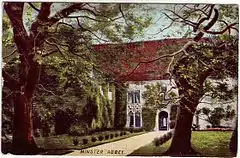Minster in Thanet Priory
Minster Abbey is the name of two abbeys in Minster-in-Thanet, Kent, England. The first was a 7th-century foundation which lasted until the Dissolution of the Monasteries. Beside its ruins is St Mildred's Priory, a Benedictine community of women founded in 1937.[1]
| St Mildred's Priory, Minster-in-Thanet | |
|---|---|
 Minster Abbey on a postcard (ca 1905) | |
 St Mildred's Priory, Minster-in-Thanet Location within Kent | |
| OS grid reference | TR313644 |
| Civil parish |
|
| District | |
| Shire county | |
| Region | |
| Country | England |
| Sovereign state | United Kingdom |
| Post town | RAMSGATE |
| Postcode district | CT12 |
| Police | Kent |
| Fire | Kent |
| Ambulance | South East Coast |
History
According to the Kentish Royal Legend, Minster Abbey was a double monastery founded AD 670 by Domne Eafe or Domneva; Eormenburg or Ermenburga is either her original name or that of her sister. Domne Eafe a Kentish princess who accepted land for a house of prayer as wergild for the killing of her brothers Æthelred and Æthelberht. The story is that she was granted as much land as her pet deer could run around in a day, whence the deer used to symbolise Minster-in-Thanet.[2]
Domne Eafe was succeeded as abbess in about 700 by her daughter Mildrith (Mildred), who was succeeded by Edburga, daughter of King Centwine of the West Saxons.[3] At the end of the eighth century the abbess was Selethryth, sister of King Offa of Mercia, and she was remembered for recovering estates of the abbey which had been seized by Archbishop Wulfred of Canterbury. She was succeeded by Abbess Cwoenthryth.[4]
According to late traditions the abbey was sacked by the Vikings in about 855, but at the end of the ninth century Asser wrote in the present tense that "an excellent minster is established on the island". The boundary of the community is mentioned in Charter S 535 of 948.[5]
At the Reformation the abbeys were dissolved and Minster Abbey became Crown property. It became a private house until in 1937 it was bought by Benedictine nuns from St Walburga's Abbey in Eichstatt, Bavaria as a refuge from persecution and became a dependent Priory.
In 1953 a small relic of St Mildred was returned to Minster from Deventer in the Netherlands.[6]
Holy Days
- 13 July, St Mildred's feast day
- 19 November, St Ermenburga's feast day
- 12 December, St Edburga's feast day
Visiting
Most of the grounds of the abbey are closed to the public although it is possible to view the outside of the Saxon and Norman wings on guided tours. The abbey's chapel is accessible for private prayer as is the nearby parish church, St Mary the Virgin. There is a train station (Minster railway station) about 350 meters from the abbey.
References
- van Zeller, Dom Hubert (1987). Benedictine Life at Minster Abbey. Westgate on Sea, Kent: The Island Press. p. 11.
- "Minster-in-Thanet, AD 670 — Kent". Pictorial Village Signs. Waymarking.com. Retrieved 24 October 2017.
- "Medieval Sourcebook: The Correspondence of St. Boniface". Retrieved 13 September 2008.
- Brooks, Nicholas (1984). The Early History of the Church of Canterbury. Leicester University Press. pp. 184–185. ISBN 0-7185-1182-4.
- Blair, John (2005). The Church in Anglo-Saxon Society. Oxford, UK: Oxford University Press. p. 298. ISBN 978-0-19-921117-3.
- Concordia Scott, The Benedictine Nuns. Minster Abbey A short Historical & Architectural Guide. Minster Abbey. p. 10.
External links
| Wikimedia Commons has media related to St Mary the Virgin's church, Minster in Thanet. |